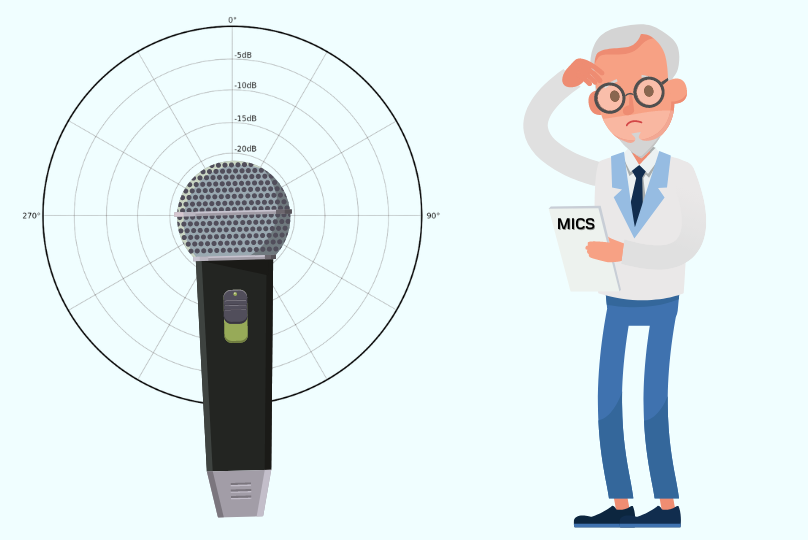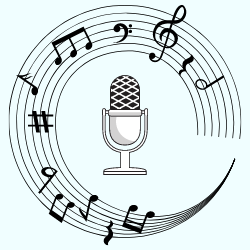What is an omnidirectional microphone? And how are omnidirectional microphones used?
If you’re setting up a home recording studio, you might be asking yourself these questions right now.
With so many different types of microphones out there, it can all get very overwhelming.
That’s why we’ve put together this in-depth guide detailing what omnidirectional microphones are, how they work, what applications they’re best suited for, and a whole lot more.
Let’s get started…
What is an Omnidirectional Microphone?
“Omni” means “all.” So, an omnidirectional mic picks up sound equally from 360º all around the device.
Omnidirectional microphones are used when you want the audience to hear sounds from all directions.
They are useful when trying to pick up multiple instruments or sounds from different people simultaneously, such as live performances of plays and musicals.
You might want to use an omnidirectional microphone in a home recording studio to pick up the room sound if you are recording a band as background music or for a live podcast with a small studio audience to capture the audience’s reactions.
Our Favorite Omnidirectional Microphone
 Shure SM63 Omnidirectional Dynamic Vocal Microphone for Handheld Applications On-Stage and in Broadcast, Recording, and TV Studios
Shure SM63 Omnidirectional Dynamic Vocal Microphone for Handheld Applications On-Stage and in Broadcast, Recording, and TV Studios
This omnidirectional microphone is sleek yet rugged, delivering remarkable performance for a variety of situations, including on stage, in the field, or in the studio.
Shure is one of the most famous and popular brands with an extraordinary reputation for making quality products. The Shure SM63 model is a great example of an omnidirectional mic that delivers exceptional sound and performance at an affordable price.
What are polar patterns?
A polar pattern is a graph showing how a mic picks up sound when viewed from above its position.
This naming comes from having a view that is like looking down on the earth from above the North Pole.
Audio engineers test microphones to determine their responsiveness to picking up sounds coming from different directions.
An omnidirectional model has a circular polar pattern that shows its ability to pick up sound equally from all directions.
Different Types of Polar Patterns
When recording, audio engineers choose devices based on their quality and their ability to pick up sounds. For picking up the room environment, an omnidirectional mic is the best choice.
The sounds picked up by an omnidirectional model are similar to what a human being can hear. Imagine you want to record the sounds of a jungle at night. Using an omnidirectional model for this project would be the perfect choice because sounds come from all directions in the jungle.
Other types of microphones are used to pick up sounds from focused directions with polar patterns that have different shapes.
This video, produced by Podcastage, discusses cardioid (e.g. a unidirectional microphone), bidirectional, and omnidirectional polar patterns.
Here are the three types of polar patterns with some examples of how they are used:
Bidirectional Polar Pattern

These devices can also be used to pick up sounds from the right and the left side to create a nicer quality and more-separated recording of the stereo field. For example, this type of microphone is used to record an orchestra’s full ambiance in stereo to capture how it sounds in a concert hall.
Unidirectional Polar Pattern

A unidirectional microphone picks up more sound coming from one direction. There are also subcategories in this group that are highly-focused mics. The pick-up pattern for this category is called “cardioid” because it is heart-shaped.
Unidirectional microphones focus on the sound coming from the front of it. They are less sensitive to sounds coming from the back and the sides of it.
A super-cardioid model has a tighter pick-up pattern than a regular cardioid one. A tighter pattern means that the unidirectional microphone focuses on sound coming from more closely to the mic head.
A hyper-cardioid model has an even tighter pick-up pattern. You will notice a steep drop-off in sound with these devices as you move the unidrectional mic further away from the sound source. These ones are useful when you want to isolate what they pick up and not capture any of the room’s sound or other sounds.
Omnidirectional Polar Pattern

They can all sing toward the microphone by standing around it in a circle.
Switchable Polar Patterns
Some devices offer the capability to switch from one polar patter to another, convenient if the use of the mic changes. You will find models with the choice of an omnidirectional or unidirectional pattern. You change the pick-up pattern by using an on-mic switch.
These models can be very helpful in home recording studios operating on a low budget. For example, you could use such a model on its unidirectional setting to record your voice-overs and on its omnidirectional setting to record Foley sound effects (such as a door slam) for a radio drama.
In this video, produced by Recordeo, there is a demonstration of different microphone polar patterns. This demonstration shows how each device is sensitive to sounds coming from different directions. It shows how an omnidirectional model sounds the same no matter where the sound comes from to reach the microphone.
Features of Omnidirectional Microphones
The main feature an omnidirectional mic is being equally sensitive to sounds coming from any direction.
This ability is accomplished by using the same sound pressure principle found in models with a single diaphragm.
There are no null points where the sound is not picked-up, and no areas are more sensitive than others.
How Omnidirectional Microphones Work
Omnidirectional devices use the pressure principle to control the air pressure on the internal diaphragm found inside the microphone’s capsule. One side of the capsule is exposed to the pressure from external sound. The other side of the capsule is secured in a fixed-pressure chamber that is about the same as the atmospheric pressure.
Sound pressure has a scalar quality.
Sound itself is omnidirectional.
Sound may emanate from a source in a certain direction.
Still, the sound pressure pattern expands in all directions from the source unless some barrier blocks it. The angle that the sound comes in to the microphone does not affect how the sound pressure makes the diaphragm move.
When the sound pressure is less than atmospheric pressure in front (the exposed part) of the diaphragm, it moves in an outward direction.
When the reverse is true, the diaphragm moves inwardly. The difference in this movement is what causes the mic to produce an output signal.
Advantages of Omnidirectional Microphones
There are many advantages for using an omnidirectional mic.
Shure gives some nice tips on omnidirectional mic advantages over regular directional microphones, which include:
- Reduced Wind Noise: Unidirectional microphones/directional microphones have acoustic ports in the rear of the microphone where air can enter. This can make unwanted noise or wind blowing by the ports makes noise. Omnidirectional models have no acoustic ports in the rear.
- Lower Plosive Sounds: Plosives are the popping sounds, which come from words that start with the letter “P” or “B.” Acoustic ports on unidirectional mics/directional microphones cause more plosives due to the wind rushing past these ports. Omnidirectional models do not have this problem as much.
- Less Proximity Effect: The proximity effect adds bass to the sound when the sound source is closer to the microphone. Omnidirectional devices have a lower proximity effect than other mic styles like directional microphones.
- Less Handling or Vibration Sound: Handling and vibration sounds are low-end frequencies. Since omnidirectional devices have less proximity effect, they are less likely to capture lower unwanted vibration or handling noise.
- Flexible Positioning: An omnidirectional model can be used right side up, forward, backward, or even upside down and the pick-up is the same.
- No Polar Pattern Pick-Up Problems: With an omnidirectional device there is no chance of speaking outside of the pick-up pattern. If you move away from the microphone, the volume will decrease by the sound will not suddenly be cut-off as can happen with a unidirectional model/directional microphone.
Disadvantages of Omnidirectional Microphones
If you want to isolate sounds and not pick up the background noise or room noise, using an omnidirectional model is a terrible idea.
For example, if you want to record a voice-over in a room where there is an air-conditioning system’s low hum, you would not want to use an omnidirectional model for this purpose. Directional microphones tend to be much better for these scenarios.
For any recording projects that you will edit the sound and make a mix, you want to isolate each sound recorded to adjust its level separately without changing the other sounds. For example, using an omnidirectional device for a singer playing guitar will pick up both the voice and the guitar and make it impossible to adjust the levels separately. Again, regular directional mics are a better choice is this scenario.
Omnidirectional mics may be problematic when used for live sound reinforcement if they are placed too close to a speaker or an amplifier because they are notorious for causing feedback problems.
Every type of mic has its own advantages and disadvantages. To learn more about condenser mics click here.
This video is an excerpt from the Audio Masterclass course called Microphone Polar Patterns and Stereo Configurations. It demonstrates an omnidirectional model and a cardioid model in a large auditorium room to show the differences at zero degrees and 90 degrees.
What are Omnidirectional Microphones Used For?
Some appropriate uses for omnidirectional models are recording nature sounds in the wild or for recording/sound reinforcement of plays and musicals to help the audience or listener hear the performers more easily.
Setting up a single omnidirectional device in the center of a group that sings toward the mic is another common use. This technique can also record any group of musicians such as barbershop singers, a classic string quartet, a bluegrass group, folk performers, a drum circle, etc. and saves the hassle of doing a multi microphone setup.
Now, if you think it sounds boring to record a string quartet, you need to check out the Bond Quartet and listen to them live from the Royal Albert Hall.
The Bond Quartet has many platinum and gold records. They sold over four million albums. They are the best-selling string quartet of all time. Mozart would be proud of them. This is not chamber music. It is more like a rock concert. The recorded sound of this concert is exceptional.
The mics used for recording their live shows include unidirectional, bidirectional, and omnidirectional. The unidirectional models are used to pick up the individual instruments. The bidirectional models are used to pick up the orchestra and backup singers. The omnidirectional models are used to pick up the shows of the auditorium and the audience applause.
How to Decide Which Mic is Best
After you get some experience with microphones with different pick-up patterns, you will get a feel for when it is best to use each one because you will know how the sound.
In this video, produced by Aputure, the hosts discuss the four common pick-up patterns: omnidirectional, cardioid, super-cardioid (shotgun), and hyper-cardioid (super shotgun) and why to choose one type over another. They show the mics in the various styles that they use for recording on film sets.
Useful Resources
- What is a dynamic microphone?
- Microphone polar patterns
- Omnidirectional microphone vs unidirectional
- How do wireless microphones work?
A Final Word on Omnidirectional Microphones
Every recording studio, audio professional, and sound reinforcement system should have some omnidirectional mics for the many wonderful uses that they support.
Even a budget home recording studio can have a mic that allows a switchable pattern from omnidirectional to unidirectional to have the desired flexibility when recording different sound sources.
I hope this overview gives you the information you need to find the best omnidirectional microphones for your sessions.







